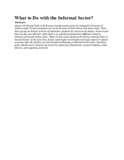| dc.contributor.author | Bigsten, A | |
| dc.contributor.author | Kimuyu, P | |
| dc.contributor.author | Lundvall, K | |
| dc.date.accessioned | 2013-06-25T06:53:27Z | |
| dc.date.available | 2013-06-25T06:53:27Z | |
| dc.date.issued | 2004 | |
| dc.identifier.citation | Development Policy Review Volume 22, Issue 6, pages 701–715, November 2004 | en |
| dc.identifier.uri | http://onlinelibrary.wiley.com/doi/10.1111/j.1467-7679.2004.00272.x/abstract | |
| dc.identifier.uri | http://erepository.uonbi.ac.ke:8080/xmlui/handle/123456789/39407 | |
| dc.description.abstract | Almost all informal firms in the Kenyan manufacturing sector are managed by Kenyans of African origin. Formal enterprises are run by Kenyans of both African and Asian origin. These three groups are distinct in terms of experience, productivity and access to finance. Asian formal firms are the most efficient, while there is no significant productivity difference between informal and formal African firms. There are thus weak incentives for African informal firms to become formal. At the same time, Kenya needs higher investments and larger exports to achieve economic take-off, and this can only be achieved through an efficient formal sector. Therefore policy should aim to integrate the sectors by improving infrastructure, capacity-building, credit delivery, and supporting networks. | en |
| dc.language.iso | en | en |
| dc.title | What to Do with the Informal Sector? | en |

